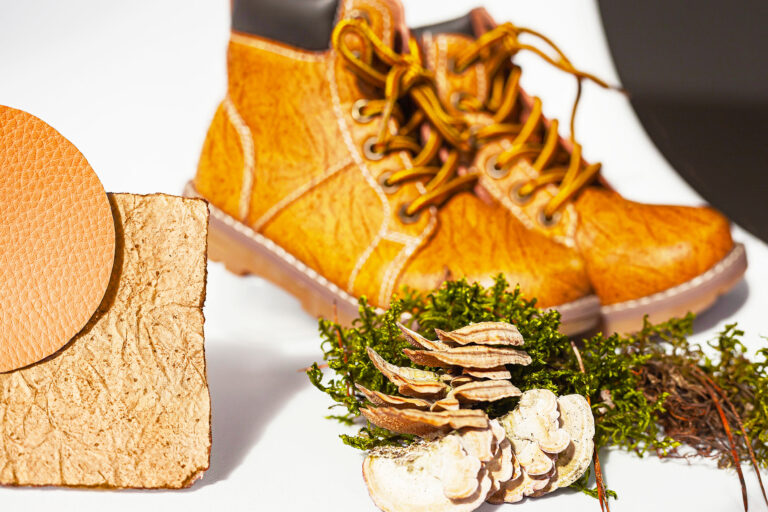The fashion world is buzzing about a game-changing new material: mushroom leather. This innovative textile made from mycelium has taken the industry by storm, offering a sustainable and stylish alternative to traditional leather.
But it’s not just about aesthetics. This fungi fashion movement aims to adopt a more environmentally friendly and cruelty-free approach to clothing production.
understanding mycelium
What’s so great about mushroom leather? It all starts with mycelium, a dense, thread-like cellular structure that forms the vegetative part of fungi.
Mycelium is made up of a network of thin white filaments called hyphae. These mycelium can penetrate various substrates such as soil, wood, and organic matter. This is the main growth structure of fungi and plays an important role in the absorption and breakdown of nutrients.
Function and ecological role
Mycelium serves as the main mode of nutrient absorption for fungi. It breaks down complex organic substances into simpler compounds that can be absorbed and utilized by fungi.
They also play an important role in ecosystems as decomposers, breaking down dead organic matter and recycling nutrients back into the soil. This process is essential for soil health and plant growth.
Symbiosis and application
Some fungi form symbiotic relationships with plants through mycelium. One example is mycorrhizal fungi, which form mutualistic relationships with plant roots, facilitating the plant’s uptake of nutrients and receiving carbohydrates in return.
Mycelium is used for a variety of applications, including agriculture (as a natural fertilizer), medicine (antibiotics and other drugs), environmental purification (bioremediation), and now textiles (mushroom skin). It is also being considered for use in sustainable materials, such as biodegradable packaging and building materials.
Mycelium, which forms the skeleton of mushroom leather
Scientists and designers have discovered that this humble creature can be harnessed to create a material that closely resembles traditional leather in texture, durability, and versatility.
Unlike animal leather, which requires intensive processing and produces hazardous waste, mycelium leather is cultivated through a natural process.
When mycelium is grown on agricultural waste and other organic matter, it can grow into sheets that can be tanned, dyed, and turned into a variety of fashion products.
“As our world seeks sustainable alternatives to traditional materials, biodegradable alternatives with lower environmental impact, such as mycelium leather, an eco-friendly leather alternative, are being developed. There is a growing interest in using and producing them,” explains the first author. Research by Asia Crawford of the University of Colorado, USA.
The environmental impact of traditional leather
Traditional leather production has a significant negative impact on the environment. Raising livestock for leather involves deforestation, water pollution, and the emission of large amounts of greenhouse gases. This process also requires large amounts of water and land, contributing to further environmental degradation.
Synthetic leather alternatives derived from petroleum-based products are not without their problems. These alternatives include fossil fuel extraction, which has its own environmental costs, such as pollution and long-term degradation.
In contrast, mycelium leather offers a more sustainable option. They do not require large areas of land, which reduces the burden on natural habitats and forests.
Mycelium leather production also requires less water, solving one of the key problems with traditional leather. Less energy is required to produce mycelium leather, making the process more efficient and less harmful.
Additionally, the mycelium leather manufacturing process produces fewer harmful by-products, contributing to cleaner and more sustainable manufacturing methods. This makes mycelial leather a promising alternative that can reduce the environmental impact of the fashion industry.
Evolution of mycelial leather
The development of mycelium leather has been a journey of innovation and experimentation. Researchers have explored different cultivation methods, improved the texture and quality of the material, and experimented with various applications in fashion and design.
Early pioneers in this field focused on growing mycelium on solid substrates such as agricultural waste. However, new techniques such as immersion fermentation have emerged, allowing greater control over the growth process and producing more uniform materials.
The future of fashion is fungi
The possibilities with new leather are endless. From high-end luxury brands to sustainable startups, designers are leveraging this versatile material to create a wide range of products. Mycelium leather is used in everything from shoes and handbags to jackets and upholstery.
But mycelium leather’s influence extends beyond the fashion industry. Its potential applications span a variety of fields, including automotive interiors, furniture, and building materials. This versatile and sustainable material could pave the way to a greener future.
Mycelium leather challenges and opportunities
Although the future looks bright for mycelium leather, there are still challenges to overcome. Scaling up production to meet growing demand remains a key hurdle. Furthermore, ensuring consistency in quality and texture between different batches of mycelial leather is an ongoing challenge.
However, as research and development progresses, these challenges are being resolved. New techniques and methods are emerging to streamline production and improve the overall quality of mycelial leather.
As consumers become more conscious of the environmental and ethical impact of their fashion choices, demand for sustainable and cruelty-free alternatives is increasing. Newly developed leather from fungi offers an attractive solution that combines style and sustainability in a way that benefits both the planet and its inhabitants.
So, the next time you update your wardrobe, consider choosing mycelium leather accessories and clothing. By supporting this innovative and eco-friendly material, you’re not just making a fashion statement, you’re contributing to a more sustainable and caring future.
The research will be published in a journal Research direction: Biotechnology design.
—–
Like what you read? Subscribe to our newsletter for fascinating articles, exclusive content and the latest updates.
Check us out on EarthSnap, the free app from Eric Ralls and Earth.com.
—–

